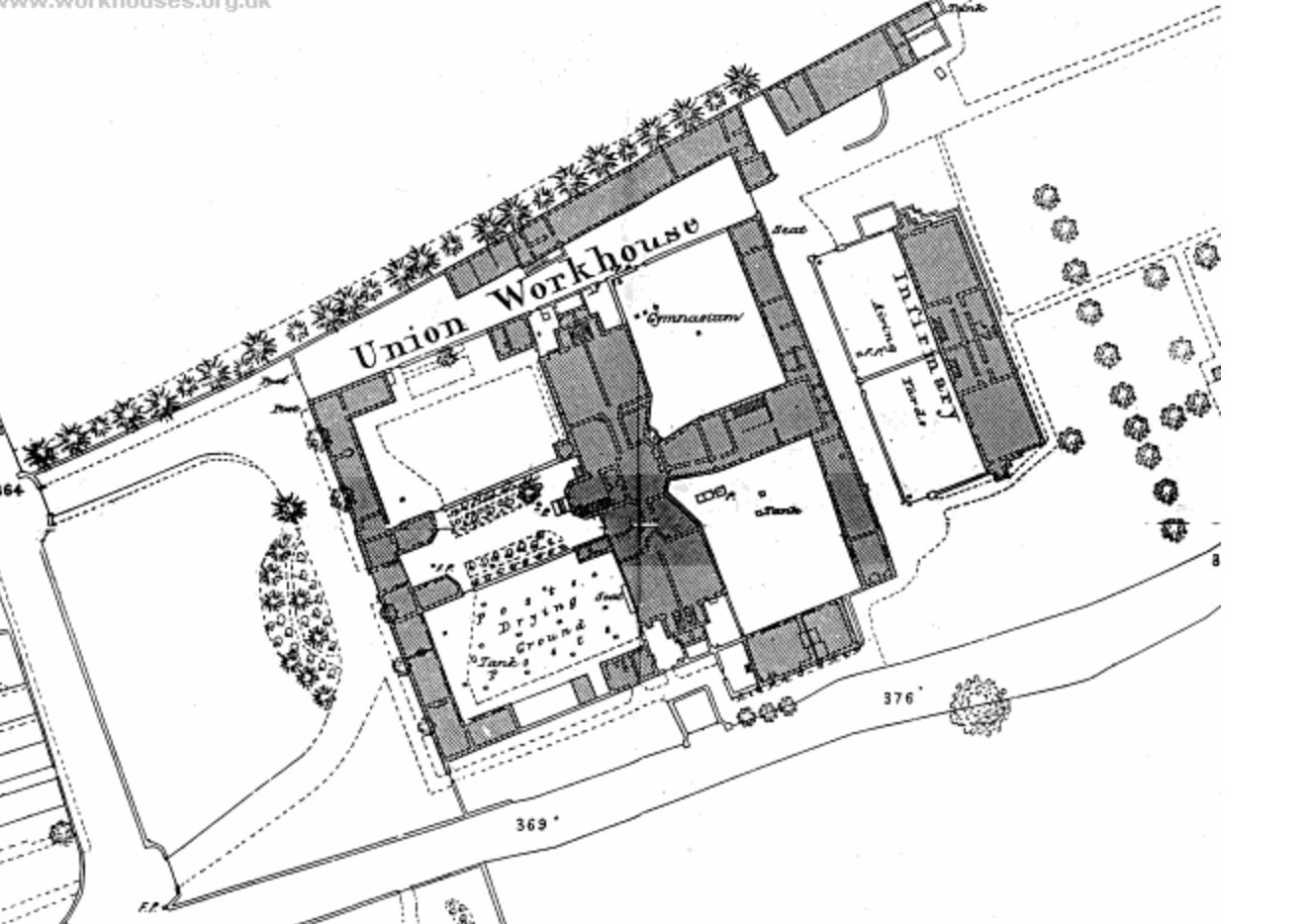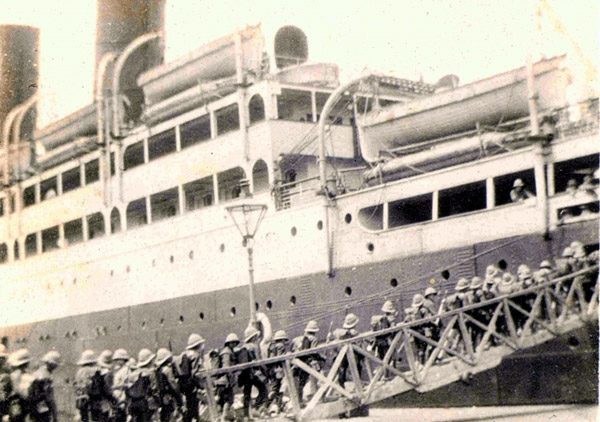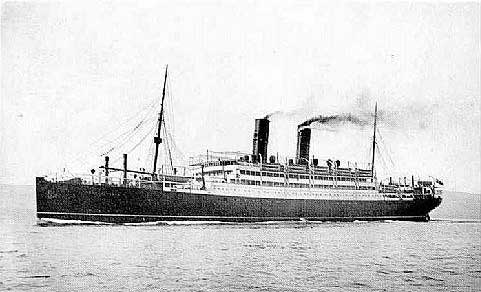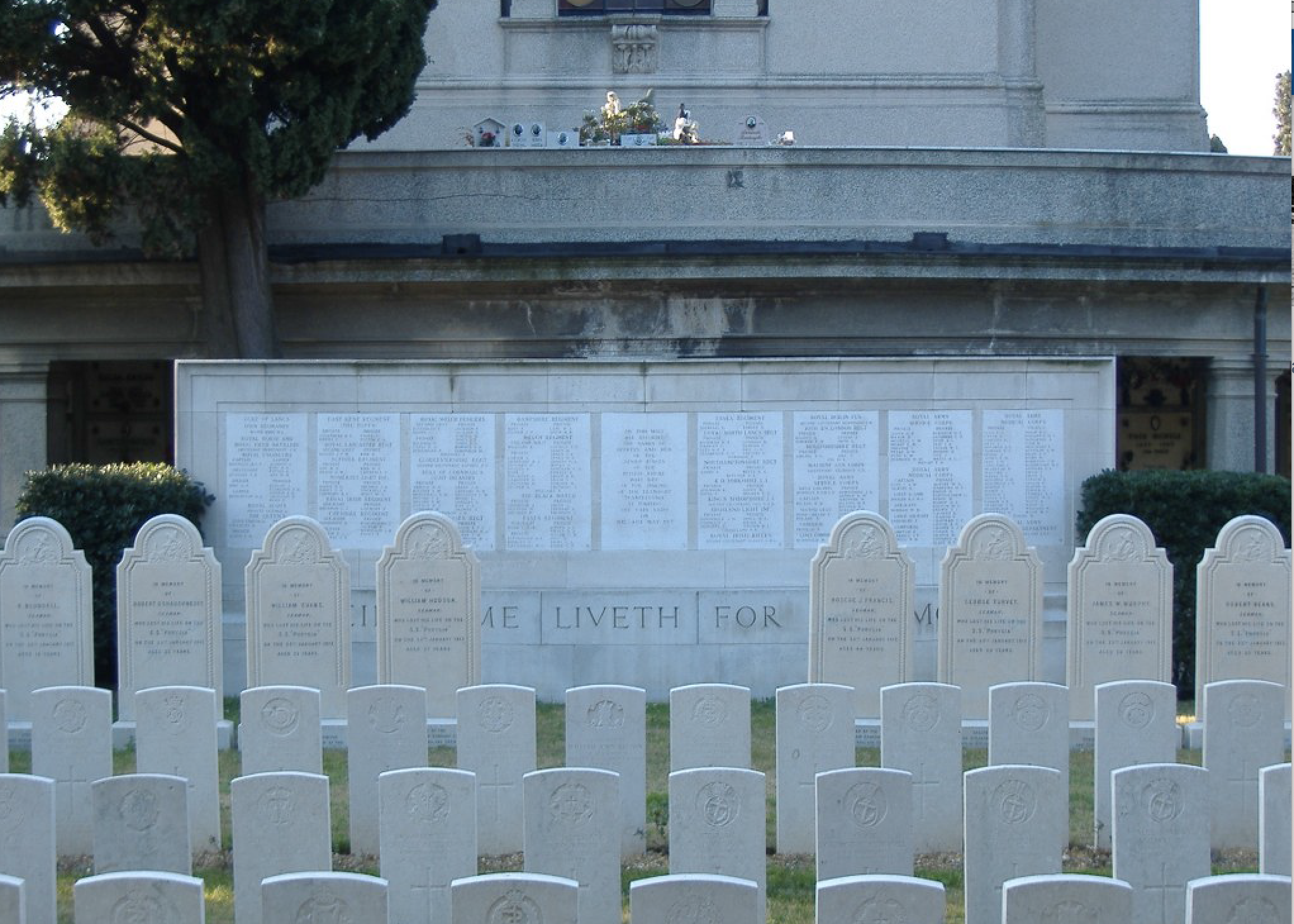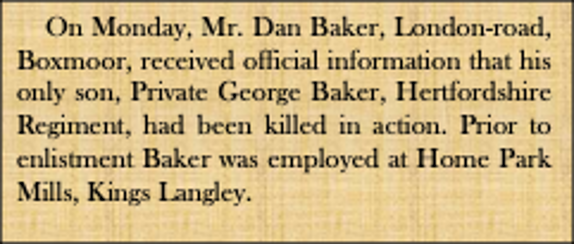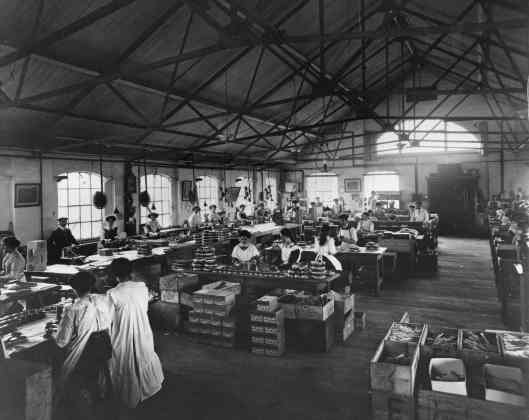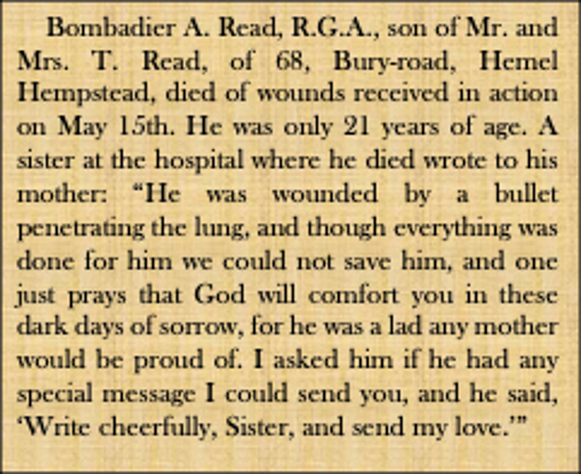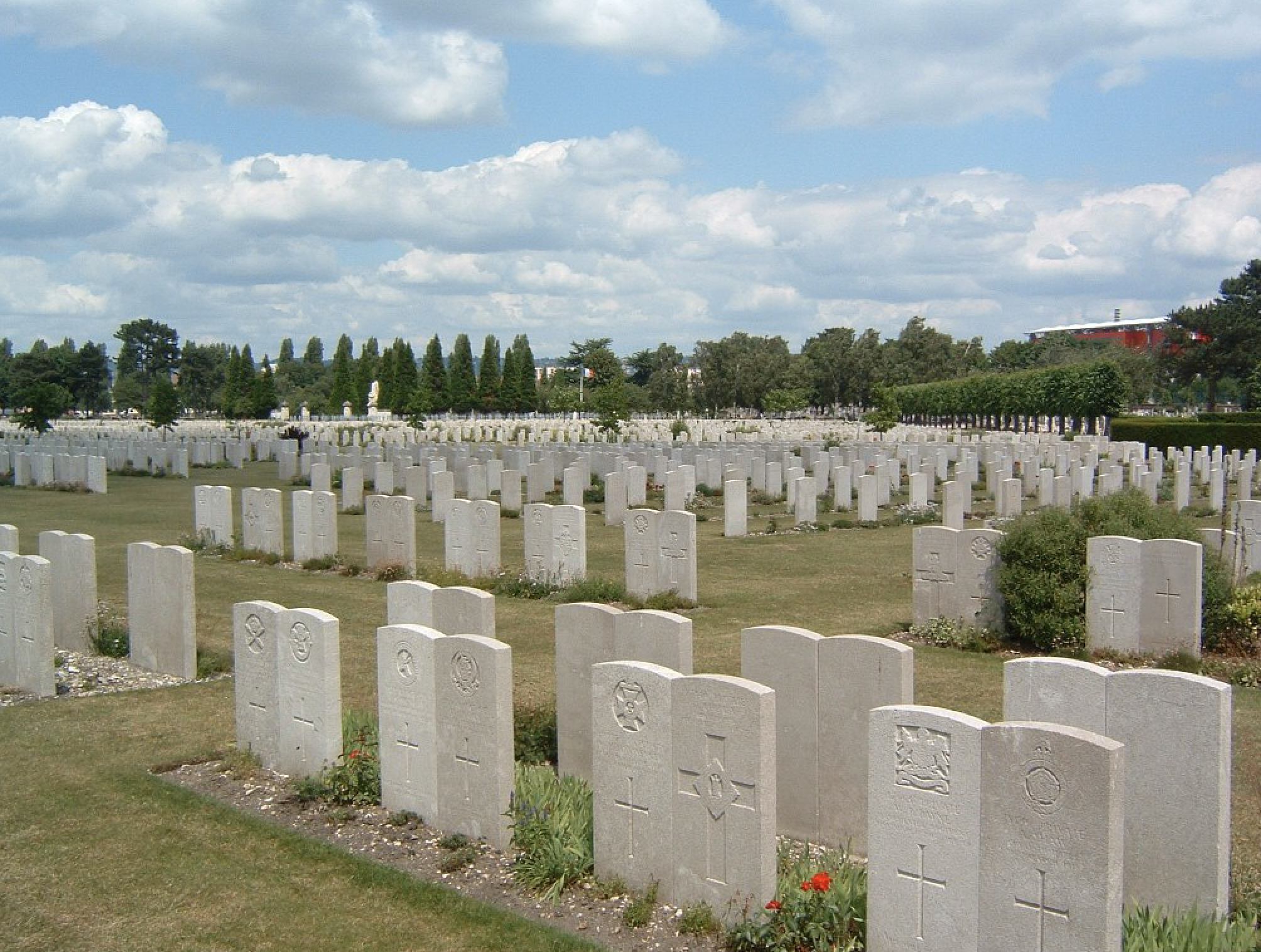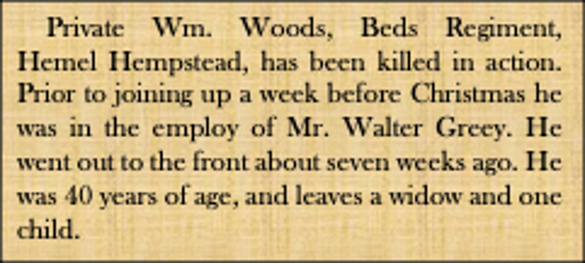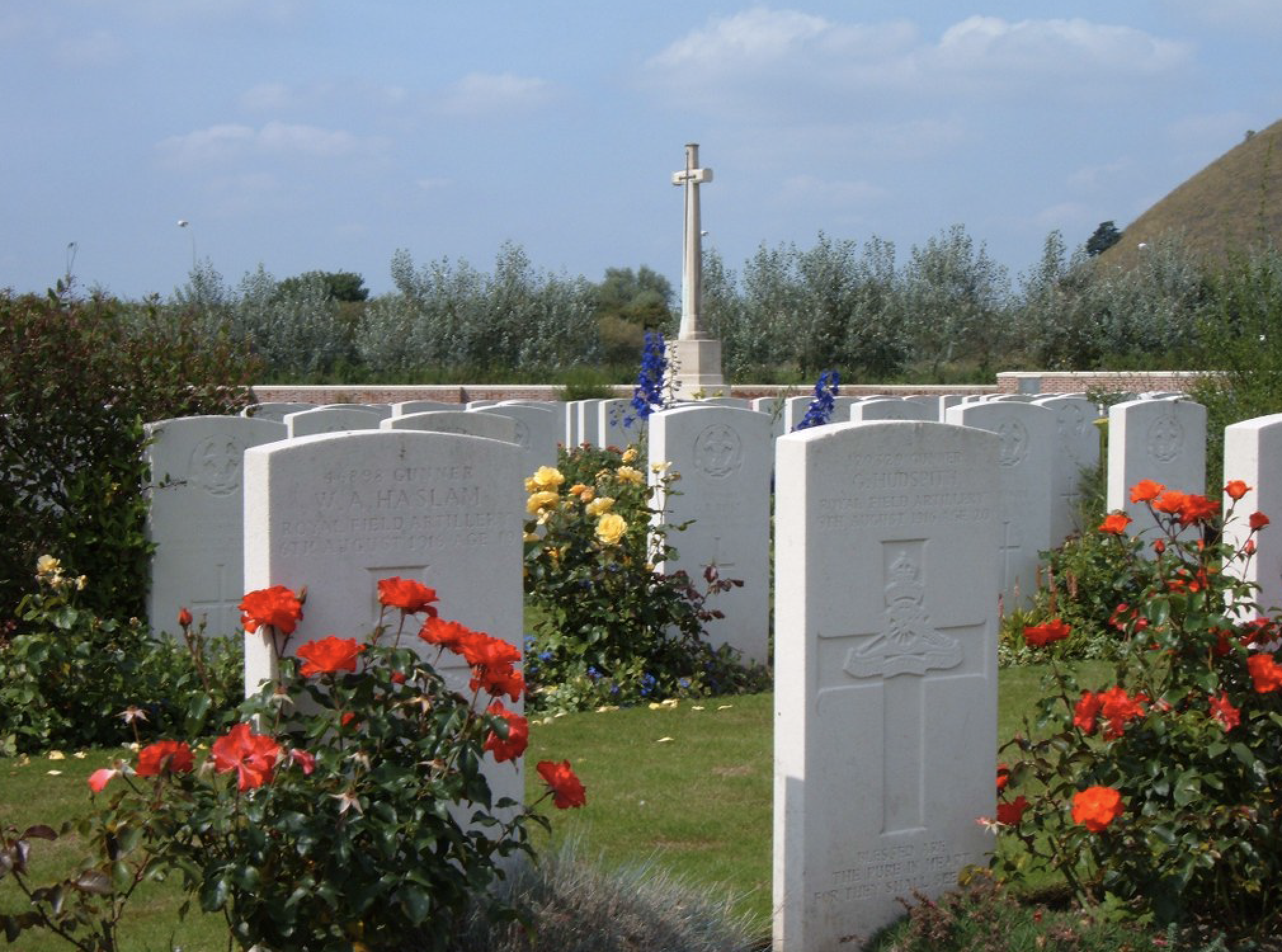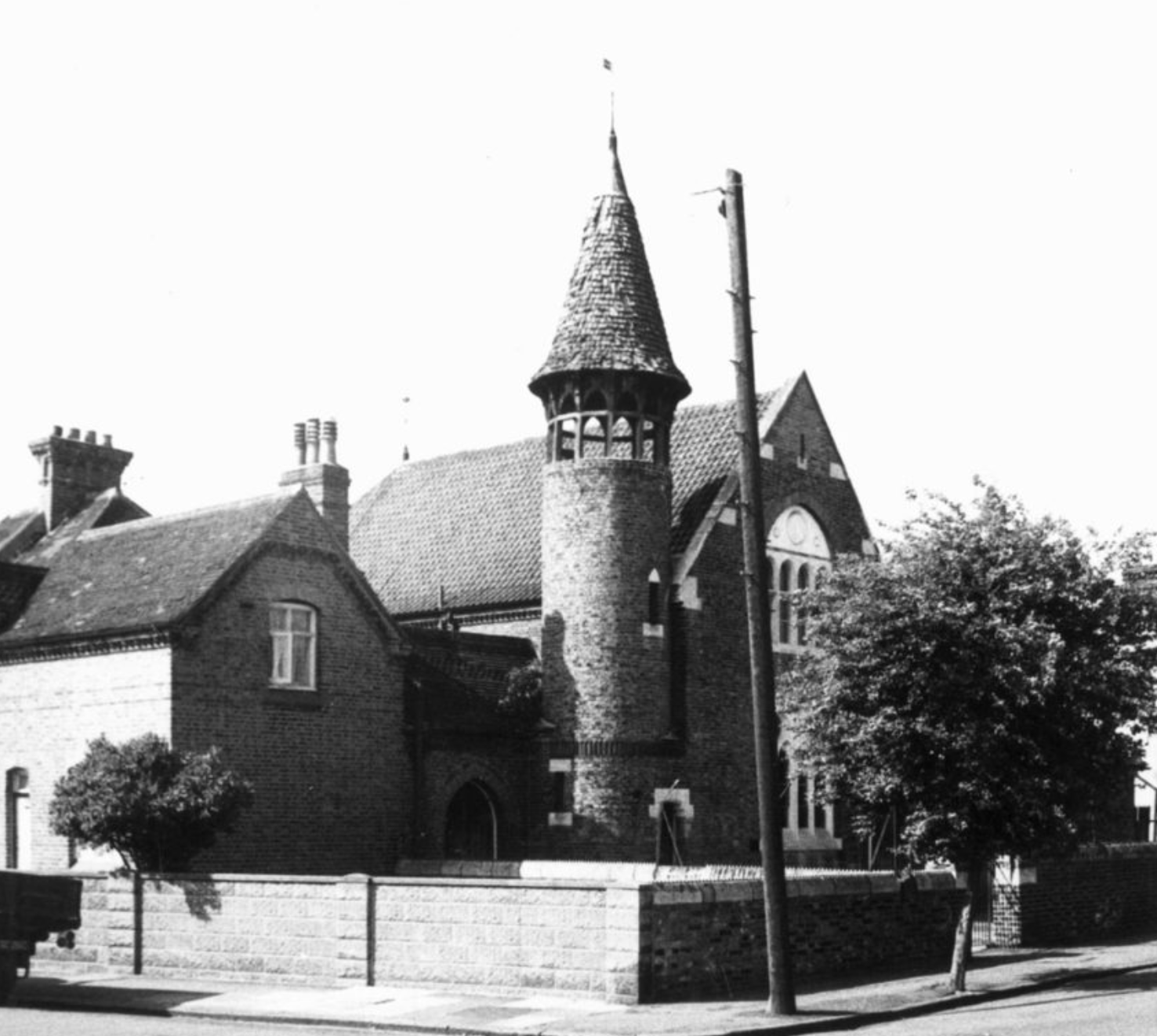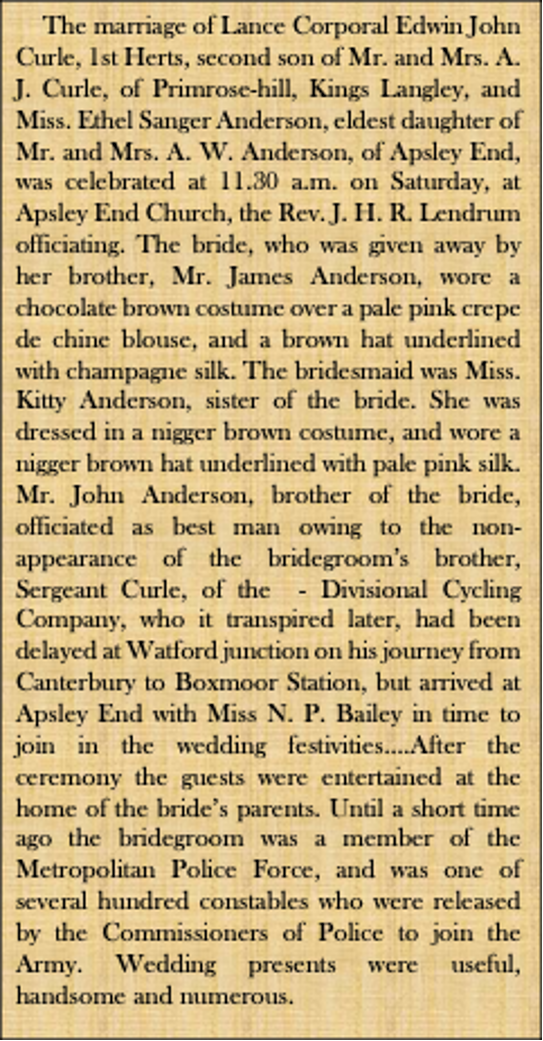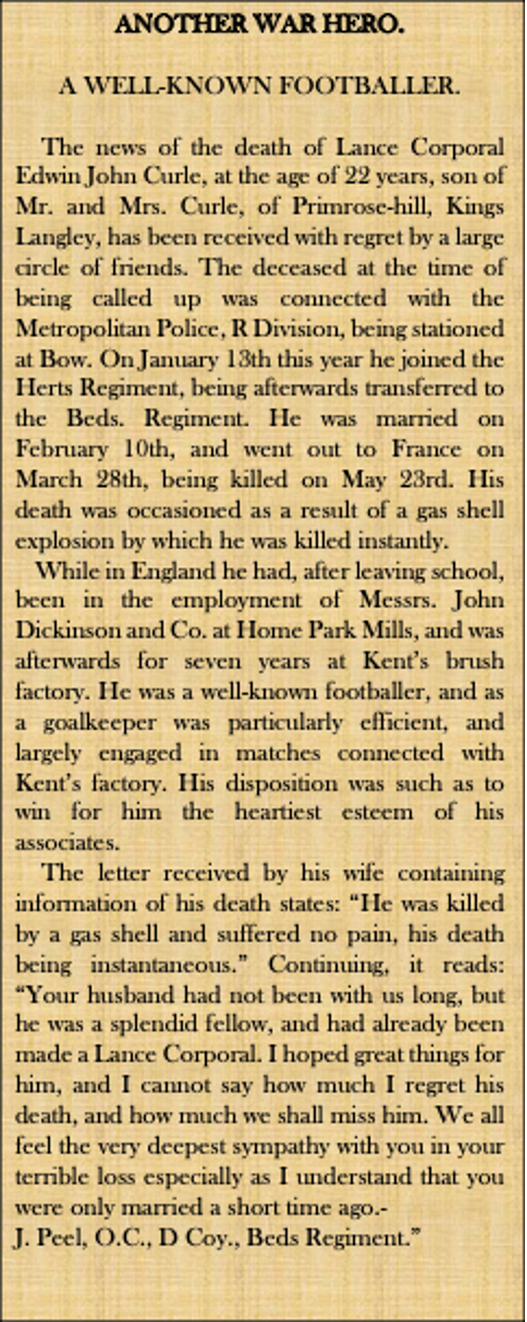Fallen in May 1917:
Joseph Hosier
William John Bisney
George Baker
Albert Read
William Woods
Edwin John Curle
JOSEPH HOSIER
20841 Private
7th Bn., Bedfordshire Regiment
Killed in Action Thursday, 3rd May 1917
Remembered with Honour, Arras Memorial, Pas-de-Calais, France, Bay 5
Joseph Hosier was born on Friday, 28th March 1890 in Hemel Hempstead and baptised in St Mary’s Church on Sunday, 17th October in the same year. He was the second child born to Joseph Hosier and Mary Ann Sells and he had one sibling, an older sister Sarah.
At the time of his birth Joseph’s family lived on Bury Hill in Hemel Hempstead just a few doors away from both his paternal and maternal Grandparents. His father Joseph worked as a ‘Bricklayer’s Labourer’.
On the 25th September 1895 Joseph started his education at Bury Mill End Infants school. The school log recorded that both Joseph and another young boy started on the same day and candidly states “Both are very backward and scarcely know their letters”. The other boy was Francis Vercoe who was a year older than Joseph and he was killed in the Great War almost exactly one month after Joseph fell. Francis’ biography also appears on this site.
When he was eight years old Joseph moved to Boxmoor JMI school, but at this point his family life becomes confusing. The school log lists his parent/guardian as one Mrs Atkins of 24 Hammerfield who may possibly have been a relation.
However, the log also records that Joseph left the school on the 3rd March 1900 because he had “gone to the Hemel Hempstead Union”, in other words to the Workhouse. This suggests that he was orphaned, and it is known that both he and his sister Sarah lived as ‘Boarders’ at the home of Thomas Lea in 1901. The Union Workhouse was situated on Queen Street (now Queensway) opposite the present day location of the Royal British Legion. It opened in 1835 and operated as a workhouse until 1920 when it became the Infirmary, before being renamed Hempstead House Public Assistance Institution in 1930 and finally St. Paul's Hospital in 1948. It closed its doors for the last time in 1970.
Six months after going into the Workhouse he had returned to Boxmoor school and was now under the guardianship of Thomas Lea of Vine Cottage on South Hill, but again Joseph left the school this time to go back to his old school, Bury Mill End. His move was “by request of Mrs Markham member of the Board of Guardians and daughter of a School Bd Member”. It is not known why the move was requested but as a ‘Guardian’ responsible for administering the ‘Poor Law’ she had the authority to make such a request.
When he eventually left school in 1903, Joseph started work as a ‘Printer’ with John Dickinson & Co Limited in the ‘Envelope Department’ in Apsley Mills. He was still with Dickinsons in 1911 and by this time had met Ethel May Hunt a work colleague in the Envelope Department. The young couple married in Hemel Hempstead in late 1913.
Joseph and Ethel set up home at 126 London Road in the Two Waters area of Boxmoor where they lived until Joseph went off to war. They were to have one child together, a daughter whom they named Violet and who was born in early 1917. Tragically, little Violet never me her father who died just a few months after she came into the world.
Joseph enlisted for service in April 1915 when he attested in Bedford and joined the Bedfordshire Regiment and was subsequently posted to the 7th (Service) Battalion known as ‘The Shiney Seventh’. Joseph completed his basic training on Salisbury Plain and following some home leave, was sent to France in February 1916 to join his Battalion at the Front. For the first few months there was no significant action but, on the 1st July, the 7th Battalion were assigned as an assault battalion in the Battle of Albert, the first engagement of the Somme offensive. Joseph fought alongside his comrades for nine days until relieved and he survived although the casualty rate was appalling.
He next fought in the battle of Bazentin Ridge on the 14th July and again came through unscathed. One month later however, Joseph was admitted to No.4 Stationary Hospital with of all things ‘Dental Caries’. Whilst this may sound trivial, the Admission and Discharge Register records eighteen soldiers admitted with the same problem over two days, by far the most common reason for admission.
Hemel Hempstead Union Workhouse, 1897 (http://www.workhouses.org.uk)
Arras Memorial, Pas-de-Calais, France (Photo: CWGC)
One hundred years ago, most men who enlisted were in good physical health because hard work was a normal part of life. Unfortunately, their teeth were often in a terrible state. At the time, hardly anyone went to the dentist on a regular basis and men with a lot of dental problems were sometimes excluded from enlisting because poor teeth could cause lots of problems for soldiers at war.
An example of the extent of dental problems amongst soldiers at the Front is revealed in New Zealand’s military archive. The country’s government set up the New Zealand Dental Corps in 1915 to deal with the extent of dental problems amongst new recruits. The archive records that at the Trentham and Featherston army camps in one group of 1998 men, the 17th Reinforcements, dentists carried out: 6335 fillings; 5237 extractions and supplied 854 dentures suggesting an average of six procedures per man. It is likely that virtually every soldier had some attention.
Joseph was in hospital for treatment for just under one month, so his treatment was either extensive of in all probability he had suffered an infection as a result of his dental problems. He returned to his unit on the 11th September and spent the last phase of the Somme offensive with the 7th Battalion in reserve.
Early 1917 saw Joseph involved in continuing operations around the Ancre until he fought in the Third Battle of the Scarpe, part of the Arras offensive. Fighting was intense, and all was confusion on the first day which saw limited gains at a high cost in terms of casualties. The Battalion War Diary recorded the following: “Officers; Killed 5, Wounded 8, Died of Wounds 1 Other Ranks ;Killed 19, Missing 48, Wounded 162, Died of Wounds 6, Missing believed Killed 4, Missing & Wounded 3”. A total of 242 men.
Joseph was one of the men ‘Killed in Action’ and he died on Thursday, 3rd May 1917.
Joseph is Remembered with Honour on the Arras Memorial, Pas-de-Calais, France on Bay 5.
He was 27 years old when he died.
Joseph was entitled to the British War Medal and the Allied Victory Medal.
WILLIAM JOHN BISNEY
G/39459 Private
2nd/4th Bn., The Queen's (Royal West Surrey Regiment)
Killed at Sea Friday, 4th May 1917
Remembered with Honour, Savona Memorial, Italy, Stone No.1
William John Bisney was born in Leverstock Green, Hertfordshire on Friday, 29th July 1892 and baptised on Thursday, 11th April 1895 at Holy Trinity Church in the village. His parents were Wallace Ernest Bisney and Kate Eliza Steers who had eight children together who were: Ernest, William John, Leonard Sidney, Harry (Henry), Percy Royal, Walter and their only daughter Violet. One other unknown child died in infancy.
Five of the six Bisney boys served in the Great War and all but William survived the conflict. The youngest boy Walter was too young to serve. Harry went first, joining the Hertfordshire Regiment and he fought at Ypres, Festubert and the Somme. He was wounded twice and taken prisoner in March 1918. Ernest joined the Norfolk Regiment and fought at Albert, Vimy Ridge, Messines and Ypres and was part of the Army of occupation in Germany at the end of the war. Percy was only seventeen-years-old when he enlisted in 1917, but went to France and fought at Messines Ridge, Ypres and Cambrai.
The Bisney family moved to Boxmoor in 1900 into Fishery Cottages on the edge of the village and next to the Grand Junction Canal, initially at number 13 before moving to number 5. William grew up living in this small row of cottages and even when he married in 1914, he set up home with his new wife next to his parents at 5 Fishery Cottages.
His father Wallace was a ‘General Dealer’ in fruit and vegetables and ran his own wholesale business. William went to school at Boxmoor JMI in the village, starting on the same day as his younger brother Leonard in February 1901. Both boys left within the year however, to continue their education at Two Waters Board School and when he left school in1905, William was the only one of the sons to follow his father into the fruit and vegetable trade.
He met local girl Mary Ann Sear and they were married in January 1914 and soon had their only child, a daughter Violet Mabel, who was born at the end of the year. William’s brother-in-law Joe Sear was also killed in the Great War in September 1914, just a couple of months before the birth of his first niece Violet.
William was called up for service in 1916, and after attesting at Watford he joined the Queen’s (Royal West Surrey Regiment) and was posted to the 2nd/4th Battalion for training. The 2/4 came under the orders of the 53rd (Welsh) Division in the 160th (Welsh Border) Brigade which fought at Gallipoli and spent the entirety of the war in the Middle East.
When his training was completed, William was mobilised and sent to Egypt to join his regiment. He travelled across France to Marseille from where he embarked for Alexandria on the 3rd May 1917 aboard the SS Transylvania. This was a relatively new ship completed just before the outbreak of war and had been ‘hired’ from the Cunard subsidiary Anchor Line, for service as a troopship.
She set sail with a full complement of troops, escorted by the Japanese destroyers Matsu and Sakaki. At 10 am on the 4th May the Transylvania was struck in the port engine room by a torpedo fired from the German U-boat U-63. At the time the ship was about two and a half miles south of Cape Vado near Savona, in the Gulf of Genoa, Italy. The Matsu came alongside the Transylvania and began to take on board troops, while the Sakaki circled to force the submarine to remain submerged.
Twenty minutes later a second torpedo was seen coming straight for the Matsu, which saved herself by going astern at full speed. The torpedo hit the Transylvania instead, which sank immediately. Ten crew members, twenty-nine army officers and 373 soldiers lost their lives.
SS Transylvania embarkation at Marseille May 1917 (Photo: https://www.azionemare.org)
SS Transylvania (Photo: https://www.azionemare.org)
Savona Memorial, Italy (Photo: CWGC)
The bodies recovered at Savona were buried two days later, from the Hospital of San Paulo, in a special plot in the town cemetery. Savona Town Cemetery contains 85 Commonwealth burials of the First World War, all but two of them casualties of the Transylvania. Within the cemetery is the Savona Memorial, which commemorates a further 275 casualties who died when the Transylvania went down, but whose graves are not known.
William was one of the unfortunate casualties and he died on Friday, 4th May 1917.
William is Remembered with Honour on the Savona Memorial, Italy, Stone No.1.
He was 24 years old when he died.
William was entitled to the British War Medal and the Allied Victory Medal.
GEORGE BAKER
26992 Private
6th Bn., Somerset Light Infantry
Killed in Action Monday, 7th May 1917
Remembered with Honour, Arras Memorial, Pas-de-Calais, France, Bay 4.
Richard George Baker, known as George, was born on London Road, Boxmoor, Hertfordshire on Sunday, 4th May 1890 and baptised in St Mary’s Church Apsley-End on Sunday 21st September in the same year. He was the only son born to Daniel Baker and Jane Dobson and he had five sisters who were Edith, Kate, both older; and Annie, Beatrice and Ellen, all younger.
George grew up and lived on London Road for his whole life and he attended the local boys school in Apsley were he began his education in 1895. He left the school in 1903 aged thirteen and went to work for John Dickinson & Co. Limited in Home Park Mills in Kings Langley. He was employed in the envelope department and he remained with the company until he went to war. His father Daniel and his two older sisters also worked for Dickinsons.
George joined the Colours under the Group or ‘Derby’ Scheme attesting at Hertford in December 1915 and joining the Hertfordshire Regiment. His enlistment record creates some confusion because his birthplace is recorded as Elmdon in Essex and research has revealed that there was indeed a George Baker born there two years before our Hemel soldier. However, all other existing military and social records verify that George was a native of Boxmoor and his father was Daniel B. Baker.
It is not known when George went to France, nor is it known if he went to join his own regiment as he transferred at some point to the Somerset Light Infantry (SLI). It is possible that he was posted to the 6th Battalion SLI when he was drafted simply to help bring that Battalion back up to fighting strength.
Regardless of the reasons or timing George found himself at the Front under the orders of the 43rd Brigade in the 14th (Light) Division. In May 1917 the 6th Battalion was near Wancourt in France approximately six miles to the south of Arras.
Starting on the 3rd May George was in action as the Battalion went onto the offensive and for the next four days the 6th Bn. SLI came under intermittent but heavy artillery and gas shelling from the enemy. By the 7th May when it was relieved the Battalion casualties incurred were as follows: “1 Officer Wounded; ORs 5 Killed 13 Wounded”. George was one of the soldiers killed.
He died on Monday 7th May 1917.
His death was reported briefly in the Hemel Gazette two weeks after he was killed. (see extract)
Somerset Light Infantry WW1 cap badge (Image: Public Domain)
Extract from The Hertfordshire, Hemel Hempstead Gazette and West Herts Advertiser 26th May 1917
Arras Memorial, Pas-de-Calais, France (Photo: CWGC)
George is Remembered with Honour on the Arras Memorial, Pas-de-Calais, France, Bay 4.
He was 24 years old when he died.
George was entitled to the British War Medal and the Allied Victory Medal.
ALBERT READ
115663 Gunner
258th Siege Bty., Royal Garrison Artillery
Died of Wounds Tuesday, 15th May 1917
Remembered with Honour, St. Sever Cemetery Extension, Rouen, Seine-Maritime, France, Grave P. II. O. 13B.
Albert Read was born in Hemel Hempstead on Monday, 3rd February 1896 and baptised at St Mary’s Church the following month on Sunday, 22nd March. His parents were Thomas Read and Carrie (Caroline) Brinklow and he had five siblings: Fred and Edith who were older and William, Harold and Arthur, all younger.
Albert grew up at 65 Bury Road in Hemel Hempstead and his father Thomas, who had been a ‘Carman’, worked for the town council as a ‘Lamplighter’ for over twenty years. After he left school in 1909, Albert followed his sister Edith into G.B. Kent and Sons Ltd and trained as a brush maker at the Frogmore factory in Apsley. He was recorded as a ‘Brush Finisher’ on the 1911 census return when he was fifteen-years-old.
Albert was called up for service in 1916 and went to Dover in August where he attested and enlisted with the Royal Garrison Artillery (RGA). He was twenty-years-old and described as 5ft 9¼ins, taller than average at that time. He was assigned to 258th Siege Battery as a Bombardier and went to begin his basic training.
Siege Batteries of the RGA were equipped with heavy howitzers, which could send large calibre high explosive shells in high trajectory known as ‘plunging fire’. They were most often employed in destroying or neutralising enemy artillery, as well as putting destructive fire down on strongpoints, dumps, store, roads and railways behind enemy lines.
Training over, Albert was sent to France with his Battery on the 27th February 1917 just over three weeks after his 21st birthday. His time at the front was tragically brief and within nine weeks of arriving, Albert was seriously wounded on the 7th May and immediately taken down the line and admitted to hospital for treatment. He was taken to No.1 Australian General Hospital at Rouen with gunshot wounds in the shoulder and one lung.
He remained in hospital for the next seven days but despite the attention of medical staff, he succumbed to his wounds and he died on Tuesday, 15th May 1917. In all Albert had been at the Front for only eighty-one days when he died.
Albert’s death was reported in the Hemel Gazette in July 1917 and touchingly tells how a nursing Sister was with him when he died and attests to his fortitude until the end. (see extract)
Five months after his death his mother Carrie received a heartbreakingly pathetic parcel containing Albert’s possessions when he was killed. These were; “Handkerchiefs, 2 discs, pocketknife, silver watch and chain (broken), gloves”. No doubt these few items were cherished by his mother.
He is commemorated on a memorial plaque at G.B. Kent and Sons Ltd in Apsley.
Albert is Remembered with Honour in the St. Sever Cemetery Extension, Rouen, Seine-Maritime, France where he is interred in Grave P. II. O. 13B.
He was only 21 years old when he died.
Albert was entitled to the British War Medal and the Allied Victory Medal.
Gnr. Albert Read c1916 (Photo: The Hertfordshire, Hemel Hempstead Gazette and West Herts Advertiser)
G.B. Kent and Sons Ltd c1910 (Image: Public Domain)
Extract from The Hertfordshire, Hemel Hempstead Gazette and West Herts Advertiser 16th Jul. 1917
St. Sever Cemetery Extension, Rouen, Seine-Maritime, France (Photo: CWGC)
WILLIE WOODS
39634 Private
8th Bn., Bedfordshire Regiment
Killed in Action Tuesday, 21st May 1917
Remembered with Honour, Philosophe British Cemetery, Mazingarbe, Pas-de-Calais, France, Grave I.P.42.
William ‘Willie’ Woods was born in Hemel Hempstead at the beginning of 1877. He was the youngest but one child of George Woods and Martha Mansell and his siblings were: Maude Louisa, Clara, George, Annie, Walter, Rosa Sarah and Samuel Leonard.
When he was born, Willie’s family lived in Ebberns Cottages on Durrants Hill near Frogmore in Apsley. His father George worked as a ‘Tanner’ probably at nearby Cornerhall where Henry Balderson had a tannery adjacent to his wharf on the Grand Junction Canal.
Willie’s mother Martha died in 1892 aged fifty-six shortly after he had started work with John Dickinson & Co Limited in Apsley Mills. Ten years later he is recorded living as a ‘Boarder’ with the Gwinnell family at Langley Bridge in Abbott’s Langley. His employment in not recorded but it seems likely that he was still working at Dickinsons.
His father George died in 1907 when Willie was aged thirty and a few years later when he was working as a ‘Carter’ for Walter Greey, who ran an upholstery business at 15 High Street in Hemel Hempstead, he was courting Charlotte Elizabeth Greenhill. Charlotte was a local girl who worked in the Envelope Department at Dickinsons where she and Willie had most probably first met.
His youngest sibling Samuel died in 1912 and just a year later Willie married his sweetheart Charlotte in Hemel Hempstead. The newly-weds set up home at 49 Bury Road in Hemel Hempstead where they had their only child Nancy Ellen in 1915.
Willie enlisted one week before Christmas 1916 when he was thirty-nine years old. He attested at Watford and joined the Bedfordshire Regiment and was posted to the 8th Battalion to train. Only three months later he was sent to France at the end of March 1917.
He saw action almost as soon as he arrived at the Front and in mid-April he fought in the Battle of Hill 70. Between the 15th and 19th of the month he experienced heavy artillery shelling and intensive machine gun fire in the trenches, as he and his comrades made fruitless attempts to gain ground.
One month later on the front line at Mazingarbe Willie was killed, the only soldier from the Battalion who died on Monday, 21st May 1917. The Unit war diary recorded the following: “21 May 1917 In trenches as above. Enemy mortars and aerial darts were active. At night a combined machine gun shoot carried out on Bde. front. Enemy retaliation feeble. Casualties 1 O.R. killed, 9 OR wounded.”
A report of his death appeared in the Hemel Gazette two weeks later at the beginning of June 1917. (see extract)
Willie is Remembered with Honour in the Philosophe British Cemetery, Mazingarbe, Pas-de-Calais, France, where he is interred in Grave I.P.42.
He was 40 years old when he died.
Willie was entitled to the British War Medal and the Allied Victory Medal.
Pte. Willie Woods c1916 (Photo courtesy: Nicola Fisher)
Willie, Charlotte and daughter Nancy c1916 (Photo courtesy: Nicola Fisher)
Extract from The Hemel Hempstead Gazette and West Herts Advertiser 2nd Jun. 1917
Philosophe British Cemetery, Mazingarbe, Pas-de-Calais, France (Photo: CWGC)
EDWIN JOHN CURLE
204244 Lance Corporal
6th Bn., Bedfordshire Regiment
Killed in Action Tuesday, 22nd May 1917
Remembered with Honour, Tank Cemetery, Guemappe, Pas de Calais, France, Sp. Mem. A. 45. ‘Buried near this spot’
Edwin John Curle was born on in Camberwell, Middlesex on Saturday, 13th October 1894. He was the fourth child born to Arthur John Curle and Eliza Grover and he had five siblings who were: Maggie Elizabeth, Edith Marion, Richard Henry, Charles William and Dorothy Ellen. His younger brother, Charles was ‘Killed in Action’ on the 30th November 1917. Charles was also a Lance Corporal and he served with the 1st/6th (City of London) Battalion (Rifles), London Regiment. He was 21 years old when he was killed and was commemorated on the Kings Langley War Memorial. At the time of Edwin’s death his older brother Richard was also serving in France and he was the only one of the three Curle boys to survive the conflict.
Edwin and his older brother Richard went to Immanuel Church of England Primary School on Streatham Common, both starting on the 20th September 1901. This was a ‘church’ school attached to the Immanuel and St Andrew’s Church just off Streatham High Street. It was designed by Sir George Gilbert Scott who build, amongst other iconic buildings, St Pancras Station and the Albert Memorial. The school still exists today.
Edwin and Richard left within a couple of weeks of each other in June 1906 when the family moved to Kings Langley in Hertfordshire. Edwin’s father Arthur was an ‘Engineer’s Labourer’ and it was this work which brought him with his family to Kings Langley when he took up a job as a ‘Furnace Stoker’ in Leavesden Asylum. The family lived on Primrose Hill in Kings Langley and on leaving school, Edwin joined John Dickinson & Co Limited at Home Park Mills.
A year later in 1907, he left Dickinsons to join G.B. Kent and Sons Limited in its Frogmore factory where he worked for seven years, during which time he earned the reputation as a goalkeeper turning out mainly for the factory team. Bothe he and his older brother Richard also played in the successful Kings Langley team between 1910 and 1914.
He left Kents in 1914 when he joined the Metropolitan Police on the 14th December 1914 as PC 104544 based in Bow where he served for the next two years. At the end of 1916, the Commissioners of the Metropolitan Police gave permission for the release of several hundred serving officers so that they could enlist for overseas service.
Edwin was one of the men who took the opportunity and, on the 13th January 1917, he attested at Poplar in Middlesex and enlisted with the 1st Battalion Hertfordshire Regiment. He was transferred not long afterwards to the 6th Battalion Bedfordshire Regiment.
Events were moving quickly for Edwin and only a month after enlisting on the 10th February, he was married to Ethel Sanger Anderson at St Mary’s Church in Apsley End. A report of the ceremony appeared in the Hemel Gazette a week later. (see extract)
The young couple were married by the Revd. James Herbert Reginald Lendrum who would be killed by a shell in August 1918 whilst conducting a burial service as an Army Chaplain at the Front.
Edwin returned to his Regiment almost immediately after his wedding and within a matter of weeks he was sent to France disembarking there on the 23rd March 1917. Within days he was in action in the First Battle of the Scarpe and two weeks later fought in the Second Battle of the Scarpe. With little respite he was in action again as the 6th Bedfordshires fought in the Battle of Arleux on the 28th April which was particularly costly in terms of casualties.
By the 19th May Edwin was back in the trenches and three days later the Battalion War Diary records the following: “22 May 1917 Very heavy shelling by hostile artillery towards evening, followed by gas shell bombardment at night. Casualties 7 killed & 14 wounded.”
Edwin was one of the seven men killed and his obituary confirmed that it was due to one of the enemy gas shells. He died on Tuesday, 22nd May 1917.
His obituary was published in the Hemel Gazette in the month following his death. (see extract)
Edwin was also commemorated at a Memorial Service in Westminster Abbey, on Saturday, 17th May 1919 for the Metropolitan policemen who had fallen in the Great War. His name is also recorded in a ‘Roll of Honour’ which is on permanent display in the Abbey.
He was also commemorated on a memorial at Forest Gate in London to the men of ‘K’ Division, Metropolitan Police who gave their lives in the Great War.
Edwin is Remembered with Honour in the Tank Cemetery, Guemappe, Pas de Calais, France on a Special Memorial A. 45. ‘Buried near this spot’. The inscription on the memorial reads: “THEIR GLORY SHALL NOT BE BLOTTED OUT”.
He was 22 years old when he died.
Edwin was entitled to the British War Medal and the Allied Victory Medal.
Immanuel CoE Primary School (Photo:https://boroughphotos.org)
Extract from The Hertfordshire, Hemel Hempstead Gazette and West Herts Advertiser 17th Feb.1917
Extract from The Hertfordshire, Hemel Hempstead Gazette and West Herts Advertiser 16th Jun. 1917
‘K’ Division Memorial, Forest Gate, London (Photo:http://www.e7-nowandthen.org)
Tank Cemetery, Guemappe, Pas de Calais, France (Photo: CWGC)
